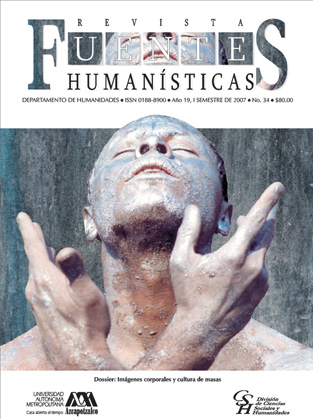Cuerpos en papel: la representación del cuerpo juvenil en el fanzine
Abstract
En este texto se quiere hacer énfasis en aquellas características estéticas que dotan de especificidad al fanzine mostrar cómo se vincula la representación del cuerpo con propuestas estéticas particulares en este tipo de publicaciones.Downloads
References
BIBLIOGRAFÍA
Bajtin, Mijail (1999) La cultura popular en
la Edad Media y en el renacimiento Madrid,
Alianza.
Barthes, Roland (et. al.) (1970) La Semiología
Argentina, Tiempo Contemporáneo.
Huizinga, Johan (2000) Homo ludens
Madrid, Alianza.
Machado Pais, José (2002) “Praxes, graffitis,
hip-hop” en Carles Feixa et al., Movimientos
juveniles en la península ibérica
Barcelona, Ariel.
Rodríguez, Félix (ed.) (2002) Comunicación
y cultura juvenil Barcelona, Ariel.
HEMEROGRAFÍA
Fanzine Anticapital, núm. 3, ca. 2001.
Fanzine Autopsia, núm. 1, 1991.
Fanzine Conciencia de Clase, núm. 4, 2002.
Fanzines Desde Abajo y Comunidad Punk,
Fanzine Histeria, número único, ca. 1986.
Fanzine Insurrekción Kontra Autoridad,
núm. 3, 2002.
Fanzine Pensares y Sentires, núm.11, 1998.
Fanzine Pensares y Sentires, núm. 16, 2000.
Fanzine Tercer Mundo Rebelde, núm. 3,
Fanzine Vamos a matarlos, núm. 9, 2001.
Orta, Miguel en Fanzine Conciencia de
Clase RASH-DF, núm. 2, ca. 2001.
Authors who publish in this journal accept the following conditions:
Fuentes Humanísticas is licensed under a Creative Commons Attribution-NonCommercial-ShareAlike 4.0 International (CC BY-NC-SA 4.0) license.
Authors retain copyright and grant the journal the right of first publication, with the work licensed under the Creative Commons Attribution license CC BY-NC-SA 4.0, which allows third parties to:
Share — copy and redistribute the material in any medium or format.
Adapt — remix, transform, and build upon the material.
The licensor cannot revoke these freedoms as long as you follow the license terms.
Under the following terms:
Attribution — You must give appropriate credit, provide a link to the license, and indicate if changes were made. You may do so in any reasonable manner, but not in any way that suggests the licensor endorses you or your use.
NonCommercial — You may not use the material for commercial purposes.
ShareAlike — If you remix, transform, or build upon the material, you must distribute your contribution under the same license as the original.
No additional restrictions — You may not apply legal terms or technological measures that legally restrict others from doing anything the license permits.
Authors may enter into other independent and additional agreements for the non-exclusive distribution of the published version of the article in this journal (e.g., placing it in an institutional repository) as long as they clearly indicate that the work was first published in this journal.






